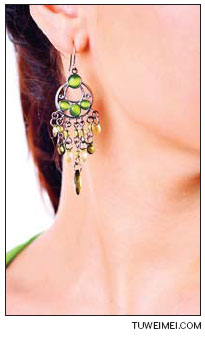Itching to wear jewelry? Think again
By Ernest Gill (China Daily)
Updated: 2010-09-01 09:17
 |
Large Medium Small |
All that glitters is not gold - as everyone who gets a rash from cheap jewelry knows - and now German scientists have proven that there is such a thing as being allergic to costume jewelry.
All modern-day "solid gold" jewelry is in fact an alloy of gold mixed with baser metals such as copper and nickel. The "carat" designation indicates the amount of gold. The higher the carat number, the more gold and less base metal there is in the piece of jewelry - and the higher the price.
In the past, it was generally assumed that the negligible amounts of base metals in "solid gold" jewelry could not possibly result in an allergic skin reaction. The new findings show that you can indeed be allergic to cheap jewelry.

For many people, wearing a pair of alloy earrings can produce a painful red swelling and blisters. Coins, belt buckles, and even mobile phones may cause an unpleasant allergic reaction when they rub against the skin.
The reason is that they all contain nickel, the most common cause of skin-contact allergies in the industrialized world. But few people realize that nickel is commonly used to make "gold" jewelry.
The researchers, led by Dr Matthias Goebeler from the University of Giessen in Germany, have shown that nickel binds to a particular immune-system protein normally involved in detecting harmful invaders. In susceptible people, this results in the body recognizing nickel as an infectious agent and triggering inflammation.
As the immune system goes into overdrive, it produces the classic symptoms of burning, itching, redness, swelling and blisters.
The scientists studied the nickel-immune response in genetically engineered mice. Only animals capable of producing the human protein TLR4 (toll-like receptor 4), developed "contact hypersensitivity" (CHS) when exposed to nickel.
Human TLR4 acts like a "switch" that triggers a cascade of biochemical reactions when certain substances bind to it. The molecular signals it gives off result in the increased blood flow, leaky tissue, and influx of immune-system cells that give rise to inflammation.
Although the reaction is due to the body defending itself, it often has undesirable side effects.
The scientists outline their findings in the journal Nature Immunology. Drugs that block specific TLR4 binding sites could provide a way of treating nickel allergy, the researchers suggest.
"Our data implicate site-specific human TLR4 inhibition as a potential strategy for therapeutic intervention in CHS that would not affect vital immune responses," the scientists write.
In Europe alone, an estimated 65 million people are sensitized to nickel and develop contact dermatitis when atoms of the metal touch their skin.